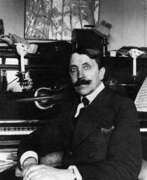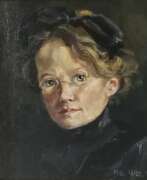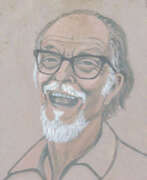Composers Portrait


Michael Vasilyevich Matyushin (Russian: Михаил Васильевич Матюшин) was a pivotal figure in Russian art and music, known for his multifaceted talents that spanned painting, composing, and theoretical contributions to the avant-garde movement. Born in Nizhny Novgorod, Russia, in 1861, he initially made his mark as a musician, becoming the first violinist of the St. Petersburg Court Orchestra after studying at the Moscow Conservatory. Matyushin's artistic journey took a significant turn when he delved into painting, studying under various tutors and eventually meeting his future wife, Elena Guro, in an artist's studio. This partnership led to the creation of the "Crane" publishing house, fostering connections with futurists and other avant-garde artists.
Matyushin is perhaps best known for his theory of "extended seeing," which focused on the exploration of space and the interactions between color, form, and perception. This innovative approach aimed at extending the boundaries of human perception, a concept he developed further through his establishment of the Zorved group. His efforts were grounded in the belief that individuals could learn to perceive more than the visible, including information and events occurring outside their immediate sensory range.
His contributions to both the visual and musical arts culminated in notable works like the futurist opera "Victory Over the Sun," where his collaboration with Kazimir Malevich and Alexei Kruchonykh marked a significant moment in avant-garde history. After the Russian Revolution, Matyushin led an art class on Color at the Free Workshops, despite facing challenges from neoclassical revivalists. Despite these obstacles, he remained a prominent figure in Leningrad's Institute of Artistic Culture, where he continued his experimental work.
Today, Matyushin's legacy is preserved in the Museum of Avant-Garde in Saint Petersburg, housed in the very building where he lived and worked alongside other luminaries of the Russian avant-garde. For art collectors and experts, Matyushin's work represents a fascinating confluence of artistic innovation and theoretical exploration, highlighting his significant impact on both Russian art and the broader avant-garde movement.
For more insights and updates on Michael Vasilyevich Matyushin's influential works and theories, sign up for updates. This subscription will keep you informed about new product sales and auction events related to Matyushin's work, ensuring you're always at the forefront of the avant-garde art scene.


Jovan Mihailović is a Serbian and American musician, artist and writer.
Jovan Mihailović was born and raised in Belgrade, the capital of Serbia, where he and his family survived the Nazi occupation and the transition to communism. From a young age, he demonstrated artistic ability and began to draw, paint and play the violin. He studied at the Belgrade Theater Academy, worked as a playwright in Yugoslavia and traveled throughout Western Europe as a folk musician before immigrating to Sweden, Canada and finally Chicago in 1971.
Jovan was an active member of Chicago's creative community for four decades, writing dozens of novels, plays, and short stories, as well as performing music in restaurants and cafes. He also created many hundreds of drawings and paintings that are full of emotionally intense images from the artist's mystical universe of beauty.


Mili Weber, full name Berta Emilie Weber, is a Swiss artist, illustrator, writer and musician.
From childhood, Mili showed an interest in nature and painting, with her older half-sister Anna being her first mentor. Mili attended the School of Arts and Crafts in Biel, where she later taught various arts and crafts subjects, she also studied at the Academy of Painting in Munich. From 1914, Mili began painting portraits of children, producing watercolor postcards with motifs from fairy tales and fables, and illustrating books. Her most famous images are of children among magical flowers. In addition to watercolor painting, Weber wrote short stories and composed music.
In 1917, the family moved to a picturesque wooden house built by Mili's brother and father on the edge of the forest near Lake St. Moritz. The most luxurious thing in this house was the organ on which she mused. Mili created her own wonderful world here: the artist decorated the ceilings and walls of the house with her marvelous frescoes of fairy tale scenes. She lived in this house all her life and now it is the home of the Mili Weber Museum, a "fairy house".

